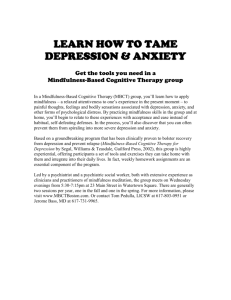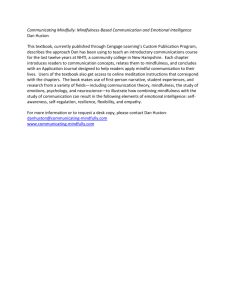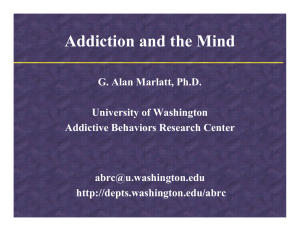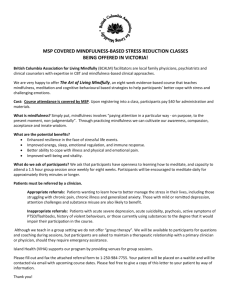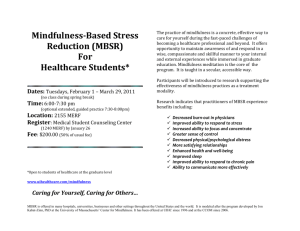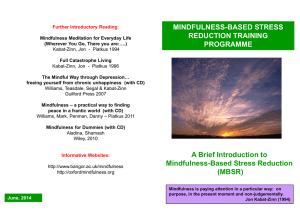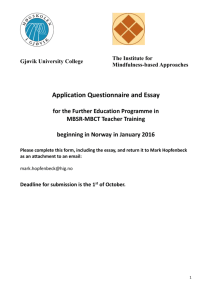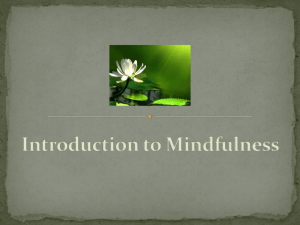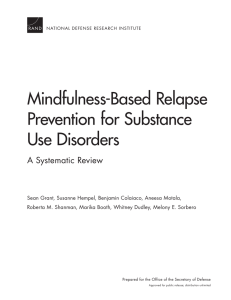Title for the slide
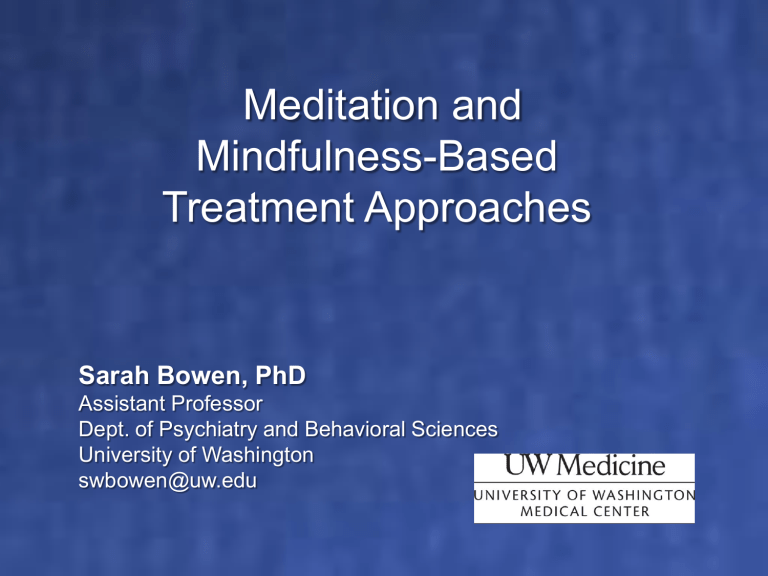
Meditation and
Mindfulness-Based
Treatment Approaches
Sarah Bowen, PhD
Assistant Professor
Dept. of Psychiatry and Behavioral Sciences
University of Washington swbowen@uw.edu
What is Mindfulness?
A systematic development of attention to present moment experience with an attitude of acceptance and nonjudging
(Bishop et al., 2004; Kabat- Zinn, 1994)
What is Mindfulness?
A systematic development of attention to present moment experience with an attitude of acceptance and nonjudging
(Bishop et al., 2004; Kabat- Zinn, 1994)
Mindfulness and Relapse Prevention
Attention,
Present,
Nonjudging
Direct
Experience
(sensation, thought,
“feeling tone”) pain
Relationship
(Reactions, stories, judgment)
“Automatic”
Past/Future suffering
Judgment/Nonacceptance
Practicing Mindfulness
(Attention)
Mind on chosen target
(Present
Moment)
(Nonjudgment)
Attention
Wanders
Notice wandering, begin again
Mindfulness: Modern History
500 B.C
.
Spanned countries / cultures for thousands of years
(Hinduism, Christianity, Islam, Buddhism)
19 th century
Came to the West via practitioners immigrating to U.S. from Asia
1960s – 70s
“Vipassana” popularized by psychotherapists and Western teachers
(Goldstein 1976; Goldstein and Kornfield, 1987)
1990s – present
“Third wave” integrates mindfulness into CBT
“Mindfulness-Based” Treatment
Psychological and medical benefits
– Depression
(Teasdale et al., 1995 Ma & Teasdale, 2004; Bondolfi et al., 2010; Kuyken et al., 2008; Segal et al., 2010)
– Anxiety
(Koszycki et al., 2007)
– Fibromyalgia
(Sephton et al., 2007)
– Cancer
(Monti et al., 2006; Hebert et al., xx; Speca et al., 2000; Foley et al, 2010)
– HIV
(Creswell et al, 2009)
– Back pain
(Morone et al., 2008)
– Rheumatoid arthritis
(Pradhan et al., 2007)
– Multiple sclerosis
(Grossman et al, 2004; 2010)
– Med and premed student stress
(Shapiro et al., 1998)
– Binge eating
(Kristeller & Hallet, 1999)
– Addiction
(Brewer et al., 2009; Bowen et al., 2006; 2009; 2010; Zgierska et al., 2009;
Vieten et al., 2009)
“Mindfulness-Based” Interventions
Formal Meditation Practice
“Home practice”
– 6 out of 7 days, 30-50 minutes
Interventions
•
Mindfulness-Based Stress Reduction (MBSR)
(Kabat-Zinn, 1986; 1992)
•
Mindfulness-Based Cognitive Therapy (MBCT)
(Segal, Teasdale & Williams, 2000)
•
Mindfulness-Based Relapse Prevention (MBRP)
(Bowen, Chawla, & Marlatt, 2009)
Mindfulness-Based Stress Reduction (MBSR)
Developed for management of chronic pain and illness
Jon Kabat-Zinn, Ph.D. and colleagues, 1979
64 studies:
Significant effects in chronic pain, stress, cancer, psoriasis, anxiety and depression
(Grossman, Niemann, Schmidt & Walach, 2003)
Mindfulness-Based Cognitive Therapy
(MBCT; Segal, Williams, & Teasdale 2002)
Prevent relapse to major depression
Awareness Change
• Recognize cognitive patterns in mild sadness
• Moods remain mild and transient vs. escalate to severe affective states
“… essential to understanding how the mind behaves and how thoughts and expectations can either facilitate or reduce the occurrence of addictive behavior.”
Marlatt, G. A. (2002). Cognitive and Behavioral Practice, 9(1), pp. 44-49.
Behavioral Model of Relapse
Vulnerabilities,
Predispositional
Factors
Temporary alleviation
Trigger
Discomfort,
Dissatisfaction Craving
Substance
Use
Relapse Cycle
Mindfulness and Substance Use
Attention:
Direct observation of the mind
Present moment:
Acknowledge/attend to present experience
Awareness of triggers and responses
Interrupt previously automatic behavior
Acceptance and Nonjudgment:
Accept the unchangeable; “defuse” from attributions and thoughts that often lead to relapse
Dismantling and Bringing Curiosity
Sensation
Thought
CRAVING
Emotion
Craving Use
Curiosity
Urge to
React
Underlying
Needs
“Urge Surfing”
Intensity
Time
Staying with discomfort as it grows,
Using breath to stay steady,
Trusting it will naturally subside
Meditation in Jail
• Minimum security jail
• Substance use charges
• 10-day Vipassana (“Insight”) meditation
• Led by appointed teachers
• “Noble Silence”
• ~ 10 hours per day of practice
• Focus on “attachment” vs. substance use
Funded by National Institute of Alcohol and Alcoholism; PI: G. Alan Marlatt
Outcomes
61% Caucasian
13% African American
8% Latino/a
8% Native American
3% Alaskan Native
2% Asian/PI
5% multiethnic or other
• N = 173 79% men Age 37
• Nonrandomized
(No BL differences on key demographic or outcome variables)
• 3-Month follow-up
• Substance Use
• Marijuana, Crack cocaine, Alcohol, Negative consequences
• Psychosocial Outcomes
• Psychiatric symptoms (depression, anxiety, hostility)
• Optimism
(Bowen et al., 2006; 2007)
Mindfulness-Based Relapse Prevention
Relapse
Prevention
• Strategies and practices from several sources
• Integrates mindfulness meditation and cognitive therapy
Mindfulness-Based
Cognitive Therapy
For Depression
• Clients have completed initial treatment
• 8-week outpatient group treatment
• 2-hour weekly sessions
Mindfulness-Based
Stress Reduction
EACH SESSION
•
Formal meditation practice
•
“Informal” mindfulness practice
•
Cognitive Behavioral skills
Eating a Raisin: Shifting out of “Autopilot”
Routine Activities: Continuous attention, natural reinforcement
Body Scan: Body awareness, Flexibility of Attention
Breath, Thought, Emotion Meditation
Awareness of processes
Urge Surfing: Relating to Discomfort
Kindness, Forgiveness: Shame, Self-Efficacy
Inquiry: Practice through Dialogue
Direct
Experience
(sensation, thought, feeling tone) pain
Relationship
(Reactions, stories, judgment) suffering
“I can’t handle this.
I need a drink.”
(craving)
Familiarity with Individual Patterns
Progressive Awareness Training
External, tangible
Thoughts, emotions, and their nature
Compassionate and skillful responding
Awareness and freedom
Pause in midst of difficulty, curiosity, what is really needed?
Body sensations
MBRP Pilot Study
N = 168
Completed
Inpatient or
Intensive
Outpatient
Baseline
MBRP
8 weeks
TAU
Post
Course
2 mos. 4 mos
(12-step, Psychoeducation,
Process/Support)
Funded by National Institute on Drug Abuse Grant R21 DAO 10562-01A1; PI: Marlatt
Participants
• Age 41; 64% male
• 50% Caucasian
• 28% African American
• 15% Multiracial
• 7% Native American
•
•
•
•
• 72% completed high-school
41% unemployed
33% public assistance
62% less than $4,999 / year
Homeless/unstably housed
45% alcohol
36% cocaine/crack
14% methamphetamines
7% opiates/heroin
5% marijuana
2% other
Results: Feasibility
• Attendance
65% of sessions
(M = 5.18, SD = 2.41)
• Formal Practice
4.74 days/week
( SD = 4.0)
29.94 minutes/day
( SD =19.5
)
(Bowen et al., 2009)
Results: Main Effects
Across 4-month follow-up, significant differences between groups:
• Mindful awareness
(p =.01)
• Acceptance
(p =.05)
• Craving
(p = .02)
• Substance Use at 2 months
(p = .02)
• Significant mediating effect of craving
(Bowen et al., 2009)
Results: Depression and Craving
Total sample
Craving
Depression
Substance
Use
Significant mediating effect of craving
MBRP
Depression
Craving
Substance
Use
Non- Significant
(Witkiewitz & Bowen, 2010)
Randomized Trial
For whom?
How?
N = 286
Baseline
MBRP
RP
TAU
8 weeks
Post 2m 4m 6m
(12-step, Psychoeducation,
Process/Support)
Funded by National Institute on Drug Abuse Grant
12m
Participants
• Age 40.6 (11.69)
• 75% male
Primary Substance
• 65% Caucasian
• 31% African American
• 10% Latino/a
• 15% Multiracial
• 2% Native American
Meth
10%
Heroin
12%
•
•
•
92% high-school or GED
71% unemployed
59% less than $4,999 / year
Marijuana
11%
Other
10%
Crack
11%
Alcohol
46%
82% polysubstance
(Bowen et al., in press)
Days of Use over Time
(Bowen et al., in press)
Primary Outcomes
•
Delay to use, Lower likelihood of use, Fewer days of use
•
MBRP & RP (vs TAU)
•
Delay to first use
•
Fewer days of use at 6 months
•
MBRP (vs RP & TAU)
•
Day of drug use at 12 months
•
Likelihood of any heavy drinking
Limitations
•
Attrition
•
Differences between TAU and active treatment groups, (e.g., therapist training, assignment of homework)
•
RP and MBRP interventions matched on time, structure and therapist training
•
Primary treatment outcome measures self-report, with limited urinalysis data
•
Self-reported substance use and urinalysis are often not significantly different
(e.g., Jain 2004; Digiusto et al., 1996)
• Continued aftercare low base rates of use at follow up
Adaptations
Adult correctional system
with Det. Kim Bogucki
Seattle Police Department, WA
Seattle Police Foundation, WA
Juvenile justice system
with Dr. Kevin King
Greenhill Juvenile Corrections School, WA
University of Washington, Seattle WA
Tobacco Cessation
with Isabel Weiss, Dr. Elisa Kozasa
Universidade Federal de São Paulo, Brazil
Client Experiences
“I paused and watched my breath
… The urges and thoughts would keep poking their heads up, but they got quieter and just weren’t as big of a deal . . . I sat until I didn’t feel like I had to act on these
“[I have] more patience with myself, thoughts and feelings. Finally, I saw the situation clearly; I could make a different choice.”
“ I am now able to regularly ‘surf’ those kinds of [triggering] situations, not just with drinking but any other discomfort or unpleasant states.” compassion. Ways to get me back into what is happening and get out of my head.”
Acknowledgments
Investigators:
G. Alan Marlatt
Katie Witkiewitz
Mary Larimer
Seema Clifasefi
Consultants:
Zindel Segal
Jon Kabat-Zinn
Research Team:
Neha Chawla
Joel Grow
Sharon Hsu
Susan Collins
Erin Harrop
Haley Douglas
Kathy Lustyk
Sara Hoang
University of
Washington
